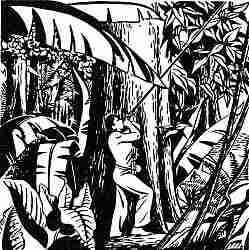 There is nothing particularly new about poisoned arrows as they
were used in prehistoric times. The word "toxic" meaning "poisonous" is
derived from the ancient Greek word "toxikos" meaning "of the bow." The
Indians of the Amazon developed this unique preparation to fit their
own particular needs however. To use it, the sharpened end of a small
arrow about ten inches long is dipped into the Curare. Around the other
end is twisted some kapok to make it air-tight when fitted into the
blow gun. The gun itself is about nine feet long and by aiming at a
bird or animal and then giving a sudden puff with the mouth, the hunter
could bring down the game within a range of approximately one hundred
feet, or about as far as one can see in the jungle.
There is nothing particularly new about poisoned arrows as they
were used in prehistoric times. The word "toxic" meaning "poisonous" is
derived from the ancient Greek word "toxikos" meaning "of the bow." The
Indians of the Amazon developed this unique preparation to fit their
own particular needs however. To use it, the sharpened end of a small
arrow about ten inches long is dipped into the Curare. Around the other
end is twisted some kapok to make it air-tight when fitted into the
blow gun. The gun itself is about nine feet long and by aiming at a
bird or animal and then giving a sudden puff with the mouth, the hunter
could bring down the game within a range of approximately one hundred
feet, or about as far as one can see in the jungle.The unusual properties of Curare become evident almost immediately after the arrow pierces the skin of the bird or animal. In a matter of seconds, the victim loses its muscular control and then can be easily picked up and carried home by the hunter. Of equal importance is the fact that the food value of game captured in this way is not in the least impaired. We usually think of poison as producing a violent reaction, but as we have seen, this material abolishes all motor impulses. |








